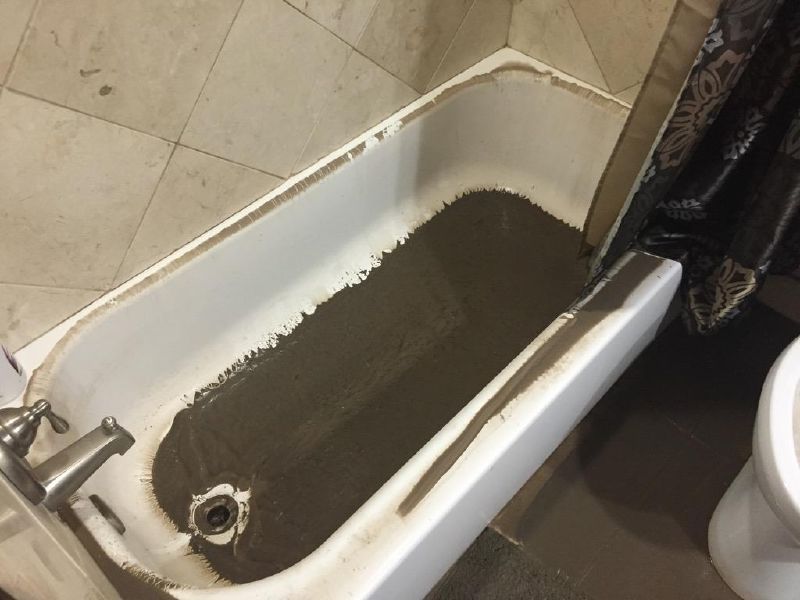Were you hunting for insight around What to Do if Sewage Starts Coming Up Through Your Bathtub?

Sewer backup in the bath tub can be a traumatic and unhygienic problem for any kind of homeowner. Not only is it inconvenient, yet it also postures severe health risks and suggests underlying concerns with the plumbing system. Comprehending why sewage is turning up via the bathtub is critical for taking proper action to resolve the problem properly.
Intro to the Concern
Usual Factors for Sewer Back-up
Obstructions in the Drain Line
One of the most usual reasons for sewage back-up is an obstruction in the drain line. This can occur due to the accumulation of particles, oil, or foreign objects in the pipes, preventing appropriate circulation and creating sewage to back up right into your tub.
Tree Origin Intrusion
Tree roots looking for dampness and nutrients can infiltrate drain lines via tiny cracks or joints. With time, these origins can expand and increase, causing considerable damage to the pipes and causing sewage backup issues.
Understanding the Issue
When sewage starts backing up into the bath tub, it's a clear sign of a trouble with the drain system. The wastewater that ought to be flowing far from your home is instead locating its back into your space, which can bring about considerable damages and carcinogen.
Potential Causes
A number of factors can add to sewer backup in the tub. From clogs in the sewage system line to issues with the plumbing facilities, recognizing the source is important for locating a solution.
Aging Framework
Older homes might have dated plumbing systems that are more prone to deterioration, splits, and wear and tear. As pipes age, they end up being a lot more susceptible to leaks and blockages, increasing the possibility of sewage back-up events.
Heavy Rainfall or Flooding
During durations of heavy rainfall or flooding, the drain system might become overloaded with excess water, causing back-ups and overflows. This can result in sewage backing up into bathtubs and various other fixtures inside the home.
Indications of Sewage Back-up
Foul Odors
Unpleasant odors rising from drains or fixtures, particularly in the washroom, may suggest sewer back-up concerns. These smells are usually strong and consistent, signaling an issue that needs instant interest.
Slow Draining Fixtures
Bath tubs, sinks, and commodes that drain pipes slowly or otherwise in any way could be experiencing sewage backup. If several components are influenced at the same time, it's likely that the issue stems from a common factor, such as the primary sewer line.
Gurgling Sounds
Unusual gurgling or gurgling noises originating from drains pipes when water is running in other places in your home are a measure of air caught in the plumbing system. This air build-up can result from sewage backup and need to be checked out quickly.
Wellness Dangers Associated with Sewage Backup
Contamination of Supply Of Water
Sewer backup can contaminate the water in your home, posing a major health and wellness danger to you and your household. Exposure to polluted water can cause gastrointestinal issues, skin infections, and various other ailments.
Mold and mildew Growth
Moisture from sewage backup can develop ideal problems for mold and mildew development in your house. Mold spores can aggravate respiratory system problems and cause allergic reactions in sensitive people, making timely cleaning crucial.
Spread of Illness
Sewer includes hazardous microorganisms, viruses, and parasites that can trigger a series of conditions, consisting of liver disease, cholera, and gastroenteritis. Coming into contact with sewage or contaminated surfaces places you in danger of infection.
Cleaning Up After Sewer Back-up
Disinfection Procedures
Completely sanitize and sanitize influenced areas after sewage back-up to eliminate harmful germs and prevent mold growth. Usage appropriate cleaning items and protective equipment to make certain risk-free and reliable cleanup.
Reconstruction of Impacted Areas
Repair any kind of damage to floor covering, wall surfaces, or fixtures caused by sewage backup. Relying on the level of the damage, you might require to change carpeting, drywall, or other materials to recover your home to its pre-loss condition.
Immediate Actions to Take
Switching Off Water
In the event of sewage back-up, it's essential to turn off the supply of water to avoid further contamination and damages. Find the primary water shutoff valve in your house and closed it off until the concern can be fixed.
Calling a Professional Plumber
Handling sewer backup is not a DIY work. Contact a licensed plumber with experience in handling sewage-related problems to assess the situation and carry out required repairs or clean-ups.
Staying Clear Of Contact with Contaminated Water
Until the sewer backup is resolved, avoid contact with contaminated water to prevent the spread of bacteria and pathogens. Put on safety gear if you need to be in the damaged location and clean your hands thoroughly later.
Safety nets
Routine Maintenance of Sewer Lines
Set up routine examinations and maintenance of your sewer lines to recognize and address possible issues prior to they rise into major troubles. This can include cleaning out particles, evaluating for tree root invasion, and fixing any broken pipelines.
Mounting Bayou Shutoffs
Take into consideration installing bayou shutoffs in your plumbing system to avoid sewer from receding right into your home throughout durations of heavy rainfall or flooding. These shutoffs instantly close when water starts backing up, protecting your building from contamination.
Proper Disposal of Household Waste
Stay clear of flushing anything besides bathroom tissue and human waste down the commode to prevent obstructions and obstructions in the drain line. Dispose of oil, oil, and various other home chemicals properly to lessen the threat of plumbing troubles.
Why is there sewage coming up from my bathtub?
These gas fumes, like hydrogen sulfide – the gas that leaves a rotten egg smell in its wake and is highly flammable and toxic – can be hazardous to your health. Sewage poses major health risks as it contains harmful bacteria and microorganisms that can be dangerous if exposed to them.
Sewage cleanup should be considered an emergency.
So, why is there sewage coming up from your bathroom? There are several common causes of a sewage backup.
The most common reason for sewage coming up through your bathroom is a clogged sewer line. All plumbing in your bathroom connects to a single drain pipe that leads to the sewer line under your house. This drain line carries all wastewater and sewage away from your home to the city’s sewer system.
When the sewer line becomes clogged or blocked, wastewater has nowhere to go but back toward your house. This results in sewage coming up through your drains, often starting with your tub or shower.
Another culprit may be the sewage ejector pump, which is used when a bathroom, laundry room or any other type of plumbing fixture is located below the level of the main sewer or septic line flowing from the house. Most commonly, ejector pumps are used in homes with basement bathrooms or laundry rooms.
When you experience sewage coming up through your bathtub, it’s always best to contact a professional. Attempts to fix a clogged sewer line without experience often lead to more plumbing damage.
Make sure that no one enters the affected area, and open as many windows as possible. Pre-treat the flooded area with small splashes of chlorine bleach. Wear protection gear like rubber gloves, a mask, and water-resistant coveralls.
https://www.shawlocal.com/the-herald-news/sponsored/2022/08/17/omega-plumbing-10199038/

I'm very serious about What To Do If Sewage Starts Backing Up Into the Shower and I am praying you appreciated the article. Sharing is good. One never knows, you may very well be doing someone a favor. Many thanks for going through it.
Call Today